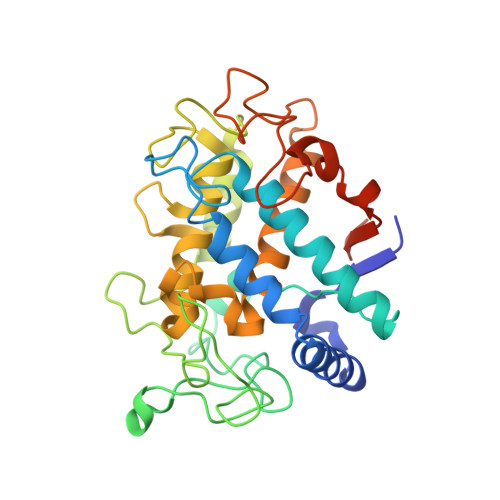Changes in tyrosinase specificity by ionic liquids and sodium dodecyl sulfate.
Goldfeder, M., Egozy, M., Shuster Ben-Yosef, V., Adir, N., Fishman, A.(2013) Appl Microbiol Biotechnol 97: 1953-1961
- PubMed: 22539021
- DOI: https://doi.org/10.1007/s00253-012-4050-z
- Primary Citation of Related Structures:
4D87 - PubMed Abstract:
Tyrosinase is a member of the type 3 copper enzyme family involved in the production of melanin in a wide range of organisms. The ability of tyrosinases to convert monophenols into diphenols has stimulated studies regarding the production of substituted catechols, important intermediates for the synthesis of pharmaceuticals, agrochemicals, polymerization inhibitors, and antioxidants. Despite its enormous potential, the use of tyrosinases for catechol synthesis has been limited due to the low monophenolase/diphenolase activity ratio. In the presence of two water miscible ionic liquids, [BMIM][BF(4)] and ethylammonium nitrate, the selectivity of a tyrosinase from Bacillus megaterium (TyrBm) was altered, and the ratio of monophenolase/diphenolase activity increased by up to 5-fold. Furthermore, the addition of sodium dodecyl sulphate (SDS) at levels of 2-50 mM increased the activity of TyrBm by 2-fold towards the natural substrates L-tyrosine and L-Dopa and 15- to 20-fold towards the non-native phenol and catechol. The R209H tyrosinase variant we previously identified as having a preferential ratio of monophenolase/diphenolase activity was shown to have a 45-fold increase in activity towards phenol in the presence of SDS. We propose that the effect of SDS on the ability of tyrosinase to convert non-natural substrates is due to the interaction of surfactant molecules with residues located at the entrance to the active site, as visualized by the newly determined crystal structure of TyrBm in the presence of SDS. The effect of SDS on R209 may enable less polar substrates such as phenol and catechol, to penetrate more efficiently into the enzyme catalytic pocket.
Organizational Affiliation:
Department of Biotechnology and Food Engineering, Technion-Israel Institute of Technology, Haifa 32000, Israel.
















